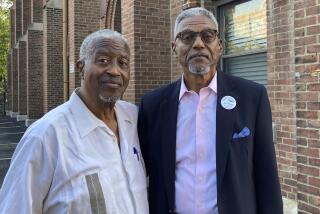Children Were Radiation Subjects, Data Shows : Experiments: The federal government and its contractors also used prisoners and psychiatric patients in testing from 1945 to the mid-1970s.
WASHINGTON — A graduate student at the University of Rochester fed radioactive milk to children, one of whom developed thyroid cancer, while other researchers injected radioactive material into psychiatric patients in San Francisco and prisoners at San Quentin, according to new data about government radiation experiments.
The findings, released Thursday, detail 100 human radiation experiments conducted by the federal government and its contractors at government labs, universities and public and private hospitals between 1945 and the mid-1970s.
The report adds to a growing body of information that the department has made public since December, 1993, when Energy Secretary Hazel O’Leary disclosed the existence of the experiments and announced a broad investigation to determine their nature and extent.
Wally Cummins, an attorney who advises the subjects of radiation experiments, said that the report shows many more people were involved, often unwittingly, than first reported. “I think it’s appalling what those people did,” said Cummins, director of the Human Experiments Litigation Project.
The 100 experiments detailed Thursday are included in a group of 154 such tests conducted on 9,000 subjects. An earlier report described the other 54 experiments.
The new study describes several experiments on children, including newborn infants, and one on Peruvian Indian mine workers.
In experiments carried out in the 1950s, researchers injected radioactive material into children with Down’s syndrome at Fernald State School in Waverly, Mass. Previous reports had described mentally retarded boys at the school who were fed radioactive food after being told that they were getting special food because of their participation in a science club.
“It’s clear, as far as individual experiments go, there is some work that would not be done today under current guidelines” for medical research, including those done on healthy children and prisoners, said Ellyn R. Weiss, director of the Department of Energy’s Office of Human Radiation Experiments. The office is investigating and making public facts about the experiments.
Researchers have been unable to determine whether the subjects in many of the experiments were asked to provide consent, Weiss said.
Many of the experiments used very small amounts of radioactive material, intended to map where the material goes in the body without doing damage, said Bill LeFurgy, deputy director of the radiation office. But the amount that can be judged safe is hotly disputed, he said.
A separate Advisory Committee on Human Radiation Experiments is to review the experiments and determine whether they were ethical. The department expects to release information on 150 more human radiation experiments by June.
Investigators continue to look at records at Lawrence Berkeley Laboratory, which was the site of about a third of all experiments, Weiss said. After World War II, scientists there were “inventing isotopes at an incredible clip,” Weiss said. “These guys wanted to get out and do work on this stuff.”
More to Read
Sign up for Essential California
The most important California stories and recommendations in your inbox every morning.
You may occasionally receive promotional content from the Los Angeles Times.









